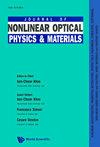线性偏振光下的狄拉克材料:电磁场下经典带电粒子轨迹的量子波函数时间演化和拓扑Berry相
IF 2.9
4区 物理与天体物理
Q2 OPTICS
引用次数: 4
摘要
在任意强场的连续波域下,分析了电子在线偏振光下对硼罗芬或石墨烯等狄拉克材料的响应。利用旋转和时间相关的相变,波函数演化被证明是由旋量分量解耦的惠特克-希尔方程控制的。这些方程的数值解可以求出准能谱。对于硼罗芬,它显示出强烈的各向异性响应。通过应用一个额外的酉变换,证明了波函数遵循一个因斯方程。波函数实部和虚部的演化被解释为一个经典带电粒子在振荡电场和磁场作用下的运动轨迹。利用这一类比研究了该强制量子系统的拓扑性质。特别地,在绝热驱动状态下,系统用有效的Matthieu方程来描述,而在非绝热状态下则需要完整的Whittaker-Hill方程。从那里,可以分离动力相位和贝里相位贡献,从而获得由于驱动而产生的拓扑相位图。因此,开发了一种不同的微扰理论路径来获得时间驱动的拓扑相。本文章由计算机程序翻译,如有差异,请以英文原文为准。
Dirac materials under linear polarized light: quantum wave function time evolution and topological Berry phases as classical charged particles trajectories under electromagnetic fields
The response of electrons under linearly polarized light in Dirac materials as borophene or graphene is analyzed in a continuous wave regime for an arbitrary intense field. Using a rotation and a time-dependent phase transformation, the wave function evolution is shown to be governed by a spinor-component decoupled Whittaker-Hill equation. The numerical solution of these equations enables to find the quasienergy spectrum. For borophene it reveals a strong anisotropic response. By applying an extra unitary transformation, the wave functions are proven to follow an Ince equation. The evolution of the real and imaginary parts of the wave function is interpreted as the trajectory of a classical charged particle under oscillating electric and magnetic field. The topological properties of this forced quantum system are studied using this analogy. In particular, in the adiabatic driving regime, the system is described with an effective Matthieu equation while in the non-adiabatic regime the full Whittaker-Hill equation is needed. From there, it is possible to separate the dynamical and Berry phase contributions to obtain the topological phase diagram due to the driving. Therefore, a different path to perturbation theory is developed to obtain time-driven topological phases.
求助全文
通过发布文献求助,成功后即可免费获取论文全文。
去求助
来源期刊
CiteScore
3.00
自引率
48.10%
发文量
53
审稿时长
3 months
期刊介绍:
This journal is devoted to the rapidly advancing research and development in the field of nonlinear interactions of light with matter. Topics of interest include, but are not limited to, nonlinear optical materials, metamaterials and plasmonics, nano-photonic structures, stimulated scatterings, harmonic generations, wave mixing, real time holography, guided waves and solitons, bistabilities, instabilities and nonlinear dynamics, and their applications in laser and coherent lightwave amplification, guiding, switching, modulation, communication and information processing. Original papers, comprehensive reviews and rapid communications reporting original theories and observations are sought for in these and related areas. This journal will also publish proceedings of important international meetings and workshops. It is intended for graduate students, scientists and researchers in academic, industrial and government research institutions.

 求助内容:
求助内容: 应助结果提醒方式:
应助结果提醒方式:


